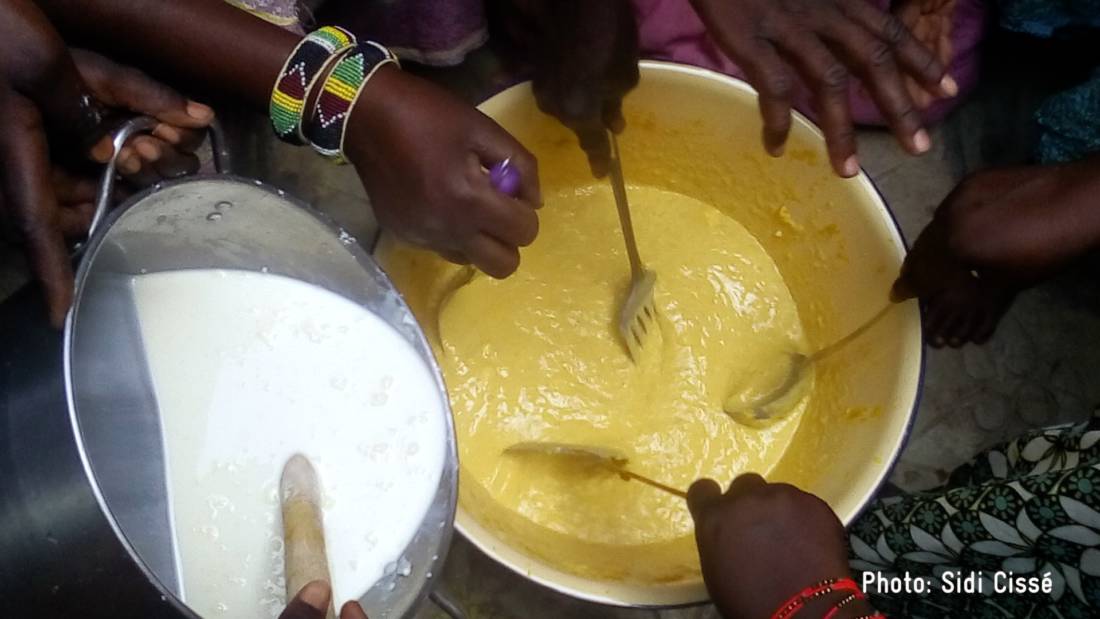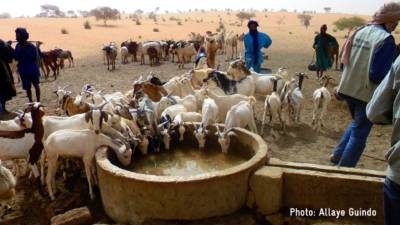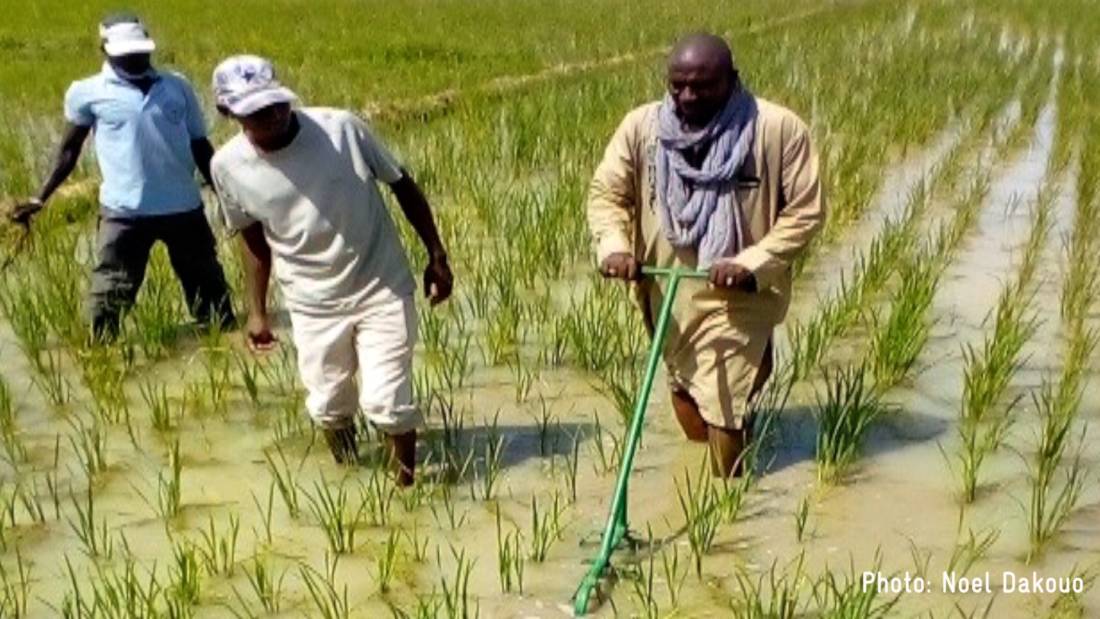Building Resilience in Mali — A Step by Step Approach
Populations throughout the Sahel find themselves in the grip of hunger and malnutrition due to structural impassés — Mali is no different, people face a chronically alarming situation which is even periodically aggravated by acute food and nutrition crises

Pumpkin porridge improved with goat fresh cream
Essentially, Mali’s population experiences food and nutrition insecurity in two closely intertwined forms: cyclically reoccurring bouts of food shortages and as a constant structural lack of various types of capacities, in its totality a lack of overall resilience. Causes for which are many and diverse in nature.
Causes for the lack of resilience in Mali
- Fragile ecosystems and degradation of natural resources
- Poor performance of production systems
- Monetary and non-monetary poverty
- Inadequate feeding practices
- Shocks and aggravating factors
- Internal and external conflicts
A common strategy
The situation of the most vulnerable populations is similar throughout all Sahel countries. Therefore, a common strategy has been devised to target people most exposed to the risks of recurring shocks, in particular, marginalized rural households in fragile ecological areas and poor urban households whose members work in the informal sector. Among these populations, special attention is paid to children under the age of five, pregnant and lactating women, female-headed households and the elderly.
The selection of the target group is based on vulnerability analyses, taking into account:
- Vulnerability of livelihoods and social welfare
- Nutrition vulnerability
- Agriculture vulnerability
- Vulnerability to the shocks (floods, droughts, pests)
- Factors aggravating food and nutrition vulnerability
- Multidimensional vulnerability, in essence a synthesis of the above factors
About the project Food and Nutrition Security, Enhanced Resilience

The GIZ project is part of the BMZ special initiative One World — No Hunger (SEWOH). In 2015, interventions commenced in the region of Timbuktu, Inner Niger Delta, also known as the Macina or Masina, which is the inland delta of the Niger River.
The project aims to strengthen resilience to food crises of populations at risk of food insecurity, particularly refugees and internally displaced persons in the process of reinstallation or returning to their country of origin. In particular, the project seeks to increase the dietary diversity of women of reproductive age, for which it adopted a multisectoral approach that combines measures in agriculture, WASH, nutrition and human capacity development.
The Global Alliance defines resilience as „the capacity of households, families, communities and vulnerable systems to face uncertainty and the risk of shock, to resist to shock, to answer efficiently, to recover and to sustainably adapt itself »
The project is completely aligned with national food and nutrition security policies and strategies, including Mali’s resilience priorities: The West African country joined the regional strategic initiative aiming at “zero hunger” by 2035 and declared its commitment to resilience strengthening of populations vulnerable to food and nutrition insecurity within the framework of the Global Alliance for Resilience in the Sahel and West Africa in 2012. This commitment was reaffirmed at the 29th annual meeting of the Food Crisis Prevention Network in 2013. A focal point has been appointed and a workgroup set up in 2014.
The project’s institutional enhancement action plan
This meta-plan coordinates food and nutrition security action plans at national, regional and local levels and aims to strengthen the authorities’ capacities at these levels. Of concern is, in particular, their capacities to give aspects of resilience to food and nutrition crises heightened attention. More consideration can only be given if:
- Resilience to food and nutrition crises is considered in the economic, social and cultural development plan at the local level
- The regional food and nutrition committee is functional — providing evidence of improved knowledge of its members with regard to the principles of resilience to food and nutrition crises as promulgated by the Global Alliance
- Resilience to food and nutrition crises evidently receives increased attention by the Technical Committee of the National Food and Nutrition scheme
Current challenges
The project struggles with partners’ ubiquitous capacity limits in order to continue with the roll-out of best practices at national, regional and local levels. To support the partners and tackle their limitations aparticipatory approach has been chosen. It identifies activities to enhance best practices within the country’s institutional framework. The participatory approach encompasses:
- A team meeting to review carried-out activity, suggest possible structural changens and other measures that can strengthen partners’ day-to-day practices
- Discussions with food security scheme structures and authorities in order to identify priorities
- Elaboration of the project institutional enhancement action plan
Project achievements
During the course of the last three years, the Food Security, Enhanced Resilience project in Mali carried out these activities:
- Rehabilitation/construction of 44 wells (28 pastoral and 16 rustic), improving access to drinking water for 2,130 agro-pastoral households (about 12.800 persons) and their cattle
- Technical advice and material support that contributed to improving access to rice and vegetables with high nutrition value for 10,800 people. This support also facilitated financial accessibility to foodstuffs for women through the incomes (up to 27,300 XOF each of the 3,110 women, 40% of the beneficiaries in the campaign)
- Training of 2,250 women in nutrition best practices; 30% of them already apply newly learned cooking techniques or recipes
- Technical and financial support to 20 groups (about 200 people) for income-generating activities (blow bovine, small shops, truck farming). The 2017 balance sheet shows very encouraging results, with an average increase of more than 50% of beneficiaries’ invested capital
- 199 households benefited from cash for work received for sowing on pastures. In 2017 acute crisis periods, 1,000 vulnerable households were assisted. 749 other households benefited 48,000 XOF each, to purchase foodstuffs for themselves and their cattle
- Regeneration of some 930ha of pasture, contributing to the improvement of pastoralists’ livelihoods
- 25 private and public service providers, 40 local masons and 184 women trainers, 222 members of 45 local committees were trained in agricultural production techniques, maintenance of water sources (wells), nutrition, conflict management


